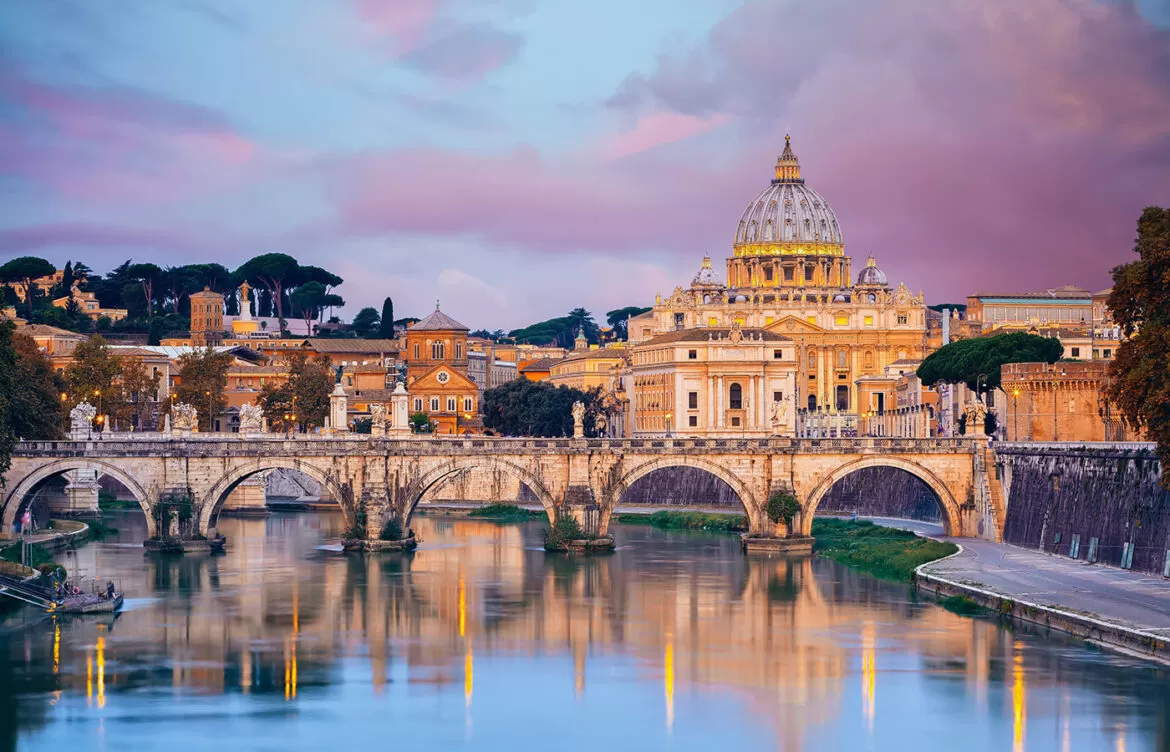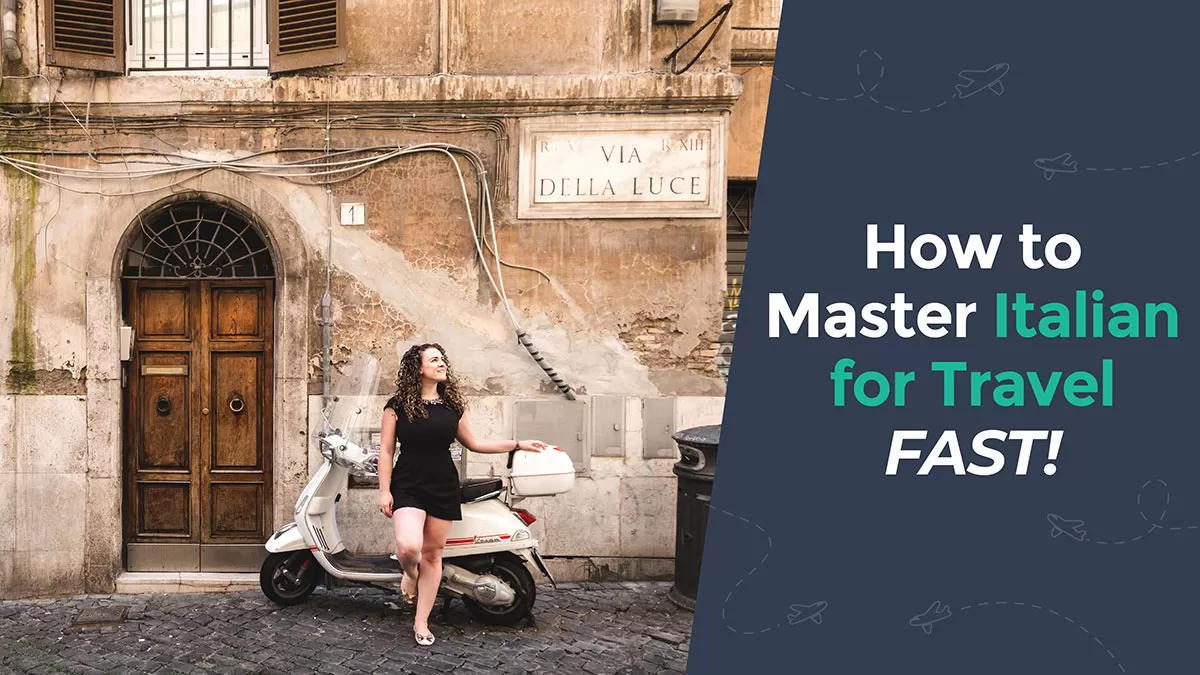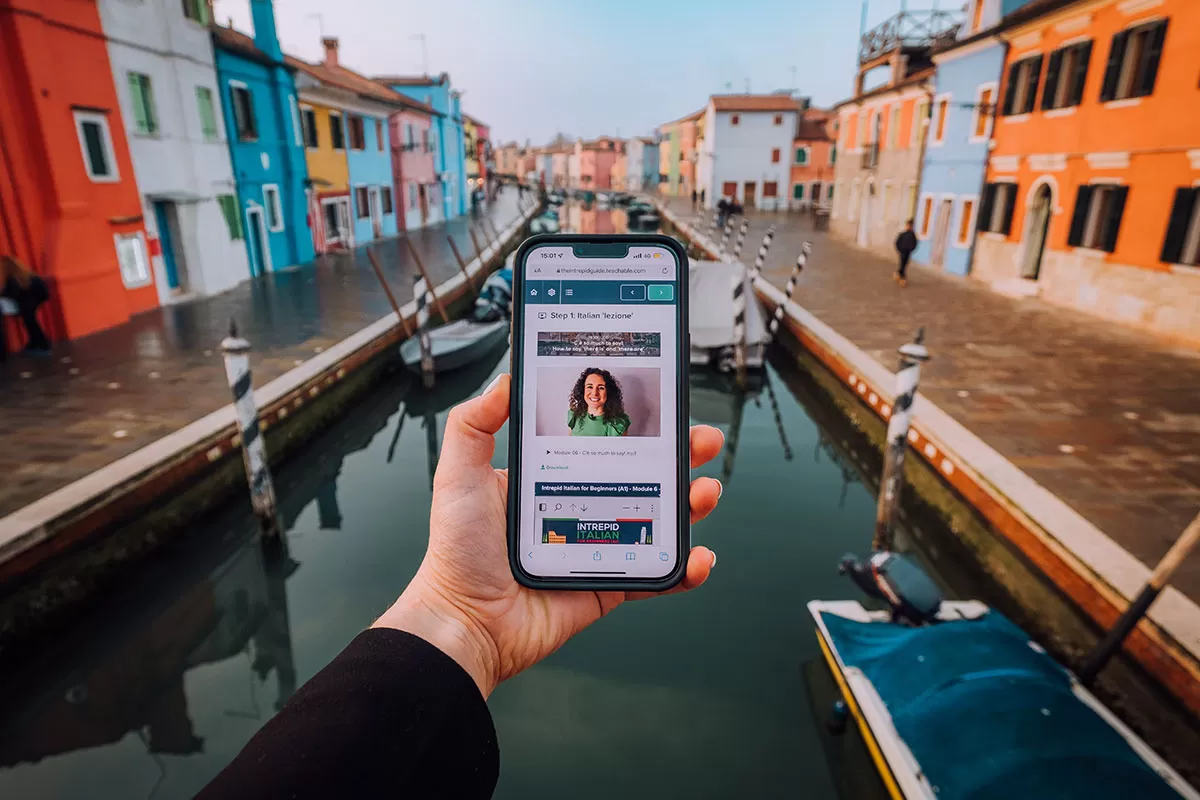From designer police uniforms to 350 types of pasta, ancient landmarks to bizarre traditions, here are 126 fun facts about Italy that you didn’t know.
Italy is a fascinating country that has had a great influence not only on European but on world culture. Italian food and Italian fashion are known and loved all over the globe. But there’s more to Italy than paintings by da Vinci, delicious pizza, and Gucci bags. I have collected over 100 interesting Italy facts that will surprise you but also help you understand this beautiful country a little bit better. Cominciamo! (Let’s get started!)
Planning a trip to Italy? Don’t miss my Italy travel tips that will save you time, money and disappointment.
The Country
Where is Italy located, how many people live there, what is its capital – all of this and other facts about the country of Italy in this section.
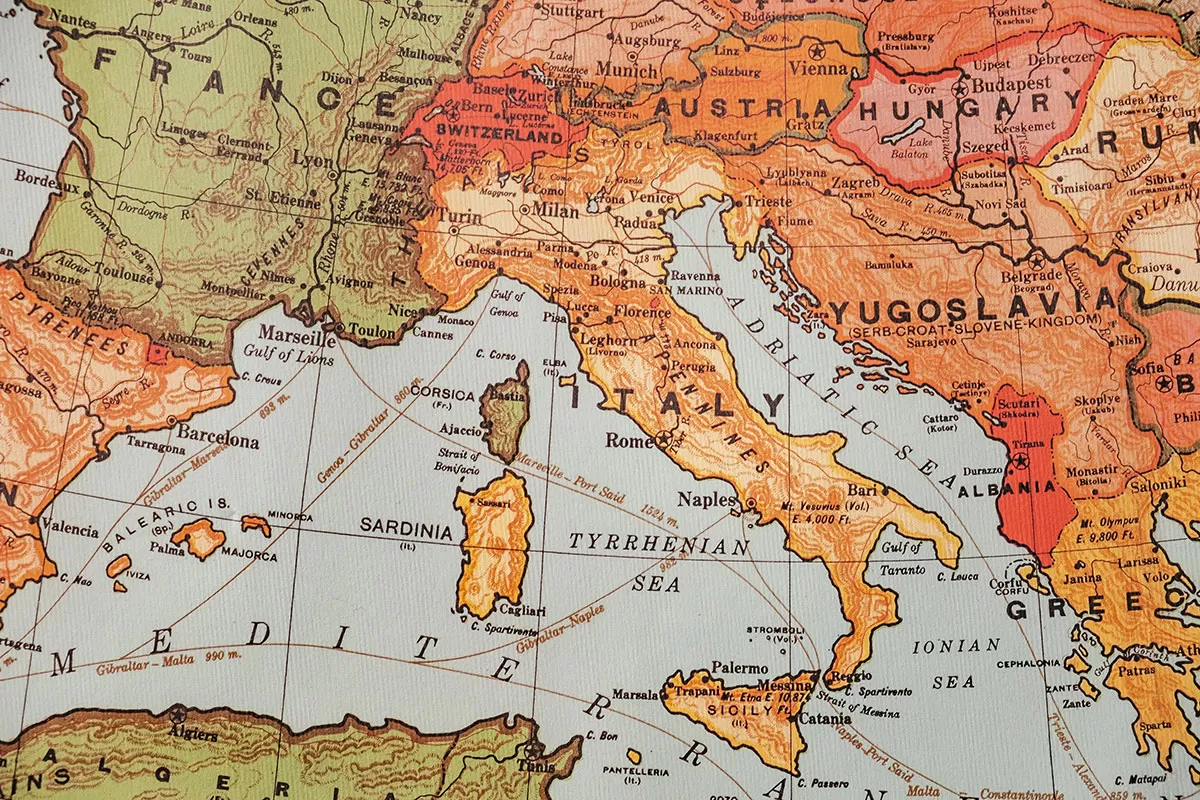
- Italy is shaped like a high boot. If you open the map of the world and zoom in onto Europe, you will see a boot-shaped country protruding into the Mediterranean Sea – that’s Italy. It is a coincidence then that Italian shoes are some of the best in the world? There is even a saying, ‘Long-legged Italia, kicked poor Sicily, right into the middle of the Mediterranean Sea.’
- As Italy is a peninsula largely located in the Mediterranean Sea, it has over 7,600 kilometers of coastline with some amazing beaches.
- The population of Italy is a little over 60 million people. That makes Italy the world’s 23rd country by population. After Germany, France, and the United Kingdom, Italy is the fourth most populated country in Europe.
- The Italian island of Sardinia is one of five regions in the world to be called a Blue Zone. A Blue Zone is where a higher than usual number of people live much longer than average. The other ‘Blue Zones‘ include Okinawa (Japan); Nicoya (Costa Rica); Icaria (Greece); and among the Seventh-day Adventists in Loma Linda, California,
- Rome, the capital of Italy, is one of the oldest cities of the world – it was founded in 753 BCE.
- The name ‘Italy’ (‘Italia’) most likely means ‘calf land’. Originally it was spelled ‘Vitalia’, originating from the Latin ‘vitulus’, meaning ‘a one-year-old calf’.
- With around 60 million tourists a year. Italy is the world’s fifth most visited country.
- The smallest country in the world is inside Italy, namely, Rome. Vatican City has an area of 44 hectares and a population of about 825.
- The Vatican is not the only small country within Italy: there is also San Marino. It is located in the mountains in the northern part of Italy, and has an area of 61 square kilometers (23.5 sq. miles).
- The Italian flag is green, white, and red, symbolizing hope, faith, and charity.
- Italy is predominantly Christian, with around 90% of the population Roman Catholics.
- Italy’s population is one of the oldest in the world: almost 20% of Italians are older than 65.
- Before it adopted the Euro, Italy’s currency was the Lira.
- The Italian economy is the eighth largest in the world.
- The head of the Italian government is the Prime Minister. There is also a President, but he is largely a ceremonial figure. As of March 2021, the current President of Italy is Sergio Mattarella and the Prime Minister is Mario Draghi.
- Italy is divided into 20 regions. Five of them are autonomous regions (*) that have more power and independence. The names of the regions include: Abruzzo, Basilicata, Calabria, Campania, Emilia-Romagna, Friuli-Venezia Giulia*, Latium (Lazio), Liguria, Lombardia, Marche, Molise, Piemonte, Puglia (Apulia), Sardegna (Sardinia), Sicilia (Sicily), Toscana (Tuscany), Trentino-Alto Adige (Trentino-South Tyrol)*, Umbria, Valle d’Aosta (Aosta Valley)*, and Veneto.
- The Italian national anthem is called Il Canto degli Italiani (Meaning: The Song of Italians) and was written and composed in 1847, but it wasn’t until December 2017 that it was officially recognised as Italy’s national anthem!
History of Italy
Italy has a long eventful history, full of events that influenced not only Europe but the whole world. What are some historical Italy facts? Read on to find out.
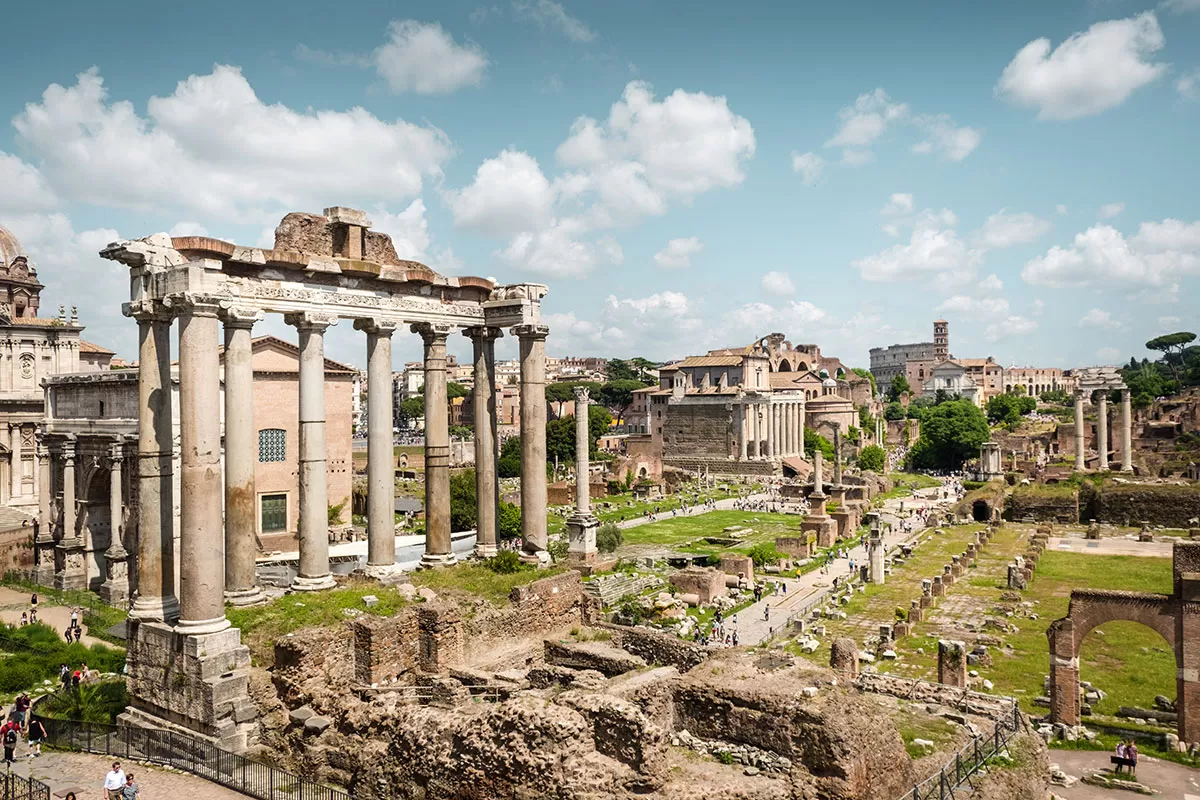
- In antiquity, Italy was the homeland of Romans and the heart of the Roman Empire, which, at its peak, occupied about 5,000,000 square kilometers – 1% of all the land on the planet.
- The Roman Empire was founded in 27 BCE and disappeared in 476 CE.
- A large part of Italy used to be Ancient Greece. For instance, the city of Syracuse in Sicily was once the largest city of Ancient Greece, and pockets of Greek culture still remain in Sicily.
- First societies emerged in Italy around 1200 BCE. However, present-day Italy only became a sovereign state and was unifed on March 17, 1861.
- For twenty years, from 1925 to 1945, Italy was under the dictatorship of Benito Mussolini.
- The first bank in the world started in Italy in 1149. The first real bank was created during the Middle Ages in Italy thanks to the fast expansion of the Maritime Republics. One of these was Genoa, where the Banco San Giorgio in Genoa was founded in 1149. The concept of a bank became so successful that it generated huge fortunes. In areas such as Florence, Pisa and Venice, the families of bankers became extremely rich and powerful. Their businesses reached as far as England, France and Spain, and they began lending money to the European sovereigns. Often the sovereigns offered feuds, baronage and other aristocratic titles instead of paying back the money they borrowed. This is how a member of the Medici family could be elected Pope and Lorenzo the Magnificent obtained the government of Florence.
- Italy is one of the six countries that founded the European Union. The other five founding countries are Belgium, France, Germany, Luxembourg and the Netherlands.
- Italy was a kingdom until 1946.
- The last king of Italy was Umberto II. He ruled for just 34 days, from 9 May 1946 to 12 June 1946, when Italy became a republic.
- The ancient city of Pompeii was destroyed by the volcano Vesuvius in 79 CE.
- Since the end of World War ll, Italy has seen 60 governments come and go.
- Italy has hosted the Olympic games three times in 1956, 1960, and 2006.
Italian Culture
Italian culture can well be called one of the most influential cultures on the planet. It has given the world some of the greatest artists, sculptures, and architects, and has to a great degree shaped western culture. Here some fun facts of Italy and its influential culture.
- Many consider Italy the art capital of the world and it is believed that Italy has more masterpieces per square meter than any other place in the world. Italian museums and galleries are amazing and are a must-visit if you travel to Italy.
- Europe’s oldest university is in Italy. The University of Bologna was founded in 1088 and still remains among the world’s best universities.
- Italian cities have historically been self-sufficient and undefended. As a result, the culture, language and traditions differ greatly from one region/city to the next.
- The story of Pinocchio was written by the Italian author Carlo Collodi and was first published in a newspaper in 1881. The Adventures of Pinocchio is children’s novel that recounts the mischievous adventures of an animated marionette named Pinocchio and his father, a poor woodcarver named Geppetto.
- People visiting the Sistine Chapel occasionally suffer from the so-called ‘Sistine Chapel syndrome’: they throw back their heads to look at the amazing frescos by Michelangelo on the ceiling, which, if you stand like that for too long, can lead to fainting.
- Some of the world’s well-known artists are from Italy: Rafael, Leonardo Da Vinci, Michelangelo, Donatello, Caravaggio, Titian, Botticelli, and Bellini.
- Italy is famous not only for its artists but for its explorers as well, including Christopher Columbus, Amerigo Vespucci, and Marco Polo. Between 1492 and 1502, Christopher Columbus led four trips across the Atlantic Ocean with the aim of finding a direct water route west from Europe to Asia. Instead, he discovered the Americas.
Vespucci was the first person to recognize North and South America as distinct continents that were previously unknown to Europeans, Asians and Africans. Vespucci discovered present-day Rio de Janeiro and Rio de la Plata. Believing he had discovered a new continent, he called South America the New World. In 1507, America was named after him. Marco Polo was a Venetian merchant who is famous for travelling to Central Asia and China, including the silk road with his father in 1271. When Polo returned from his adventures, he recounted his tales which helped introduce Europeans to Asia, and contributed to demystifying the largely unknown continent. In this influential book called The Travels of Marco Polo, Polo describes the geography of Asia, the customs of its people, and highlights China’s creativity in the use of coal, money, and compasses to improve future exploration. - Italy is also a source of great film stars, such as Monica Bellucci (Malèna, The Passion of the Christ), Robert Benigni (Life is beautiful), Isabella Rossellini (Blue Velvet), and Sophia Loren (Yesterday, Today and Tomorrow; Marriage Italian Style). Fall in love with Italy with my guide to Romantic Italian films.
- Football (or soccer), is extremely popular in Italy, with many local clubs and millions of passionate fans.
- Ballet originated in Italy in the 15th century and was introduced to France by Catherine de Medici.
- ‘Ars longa, vita brevis’ is a common saying in Italy that means ‘art is long, life is short’. This expression highlights the long-lasting impact of art over the brevity of life.
- Italy is home to 3,847 museums, galleries or collections, 240 archaeological areas or parks and 501 monuments or monumental compounds.
Italian Traditions
Italian people value their roots and observe many traditions. Take a look at this section to find out what some fun Italian traditions and customs are.

- After dinner, many Italians fare una passeggiata – take a stroll after their evening meal. You often do this as a way to help with digestion but is often a social activity and a time to catch up with friends and neighbours, to go out and be seen.
- Italy is one of the most superstitious countries in the world. There are lots of everyday superstitions that many Italians believe. For instance, it’s customary to place a loaf of bread face up not to offend Jesus; it’s back luck to celebrate your birthday before the actual date; when raising a toast, you should tap the bottom of the glass on a table to bench; and it’s bad luck to raise a toast with water or when drinking from a plastic cup.
There are also many local and regional superstitions. For example, in Naples an amulet of a red chili pepper, known as a cornicello (Italian for ‘little horn’ or ‘hornlet’) is said to bring luck and protect the bearer against the evil eye. What makes a cornicello so special is that you can’t buy it for yourself, it must be gifted to you.
Another common Italian superstition is that if you accidentally spill salt or oil on the table, this could lead to finance ruin. This idea stems from ancient times when both oil and salt were expensive commodities. In fact, Roman soldiers were paid in salt, which is how we get the word ‘salary (Italian: sale). To undo any potential harm caused from spilling these precious ingredients, you must quickly pick up the salt grains and throw them behind your shoulders three times with the left hand. Why three? This is the number of the Trinity and the left hand is associated with sinister things so in this case, evil wards off other evil. When the grains of salt land on the floor, a passerby will pick-up the bad luck instead. If you spill oil, then a single pinch of sprinkled salt will do the trick. - The family (and the mother in particular) is the centre of Italian society, with young people often living at home well into their 30s.
- Italians are known for having large families, however, at the same time, Italy is known for having the lowest birthrate in Europe.
- The biggest holiday of the year in Italy is Christmas, with the Christmas season starting as early as December 8th and lasting until January 6th.
- Cats are loved and protected in Italy. Rome alone is home to about 300,000 cats. A person convicted of killing a cat, owned or stray, can face a €10,000 fine and up to 3 years in prison. There are roughly 300,000 feral cats in Rome. In fact, the Rome city council protects them due to their ancient bond with the city, citing that they are part of the city’s ‘bio-heritage.’ A sanctuary of 250 cats was established at Largo di Torre Argentina, where Julius Caesar was assassinated by Brutus.
- Number 13 is actually considered very lucky in Italy, while number 17 is unlucky, and many tall buildings don’t have a 17th floor.
- Eating or drinking on church steps or in the church courtyard is prohibited.
- Respecting elders is essential for Italian culture. It is customary to stand up when an elderly person enters the room.
- First impressions are important in Italy, so make sure to be polite.
- Before dinner, Italians will go out for an aperitivo. The Italian aperitivo is similar in concept to ‘Happy Hour’ but drinks aren’t discounted but food is included. Originating in Milan, in Northern Italy, Italians will head to a cocktail or wine bar with friends and catch up with a relaxing post-work drink and some light snacks. Common beverages are wine, Aperol Spritz or Campari Spritz. Since most Italian eat lunch around 1pm or 2pm, and dinner around 9pm, having an aperitivo is a great way to tie them over until dinner time.
- Many Italians celebrate their name day. This Roman Catholic tradition is when, on a certain day of the year, a person celebrates their given name and can be just as important as celebrating their birthday since they were named after a saint. When someone celebrates their name day, you wish them Buon onomastico! (Happy name day!). Since my name is Michele, my name day is September 29th. If you’re named after a saint, you can check your name day here.
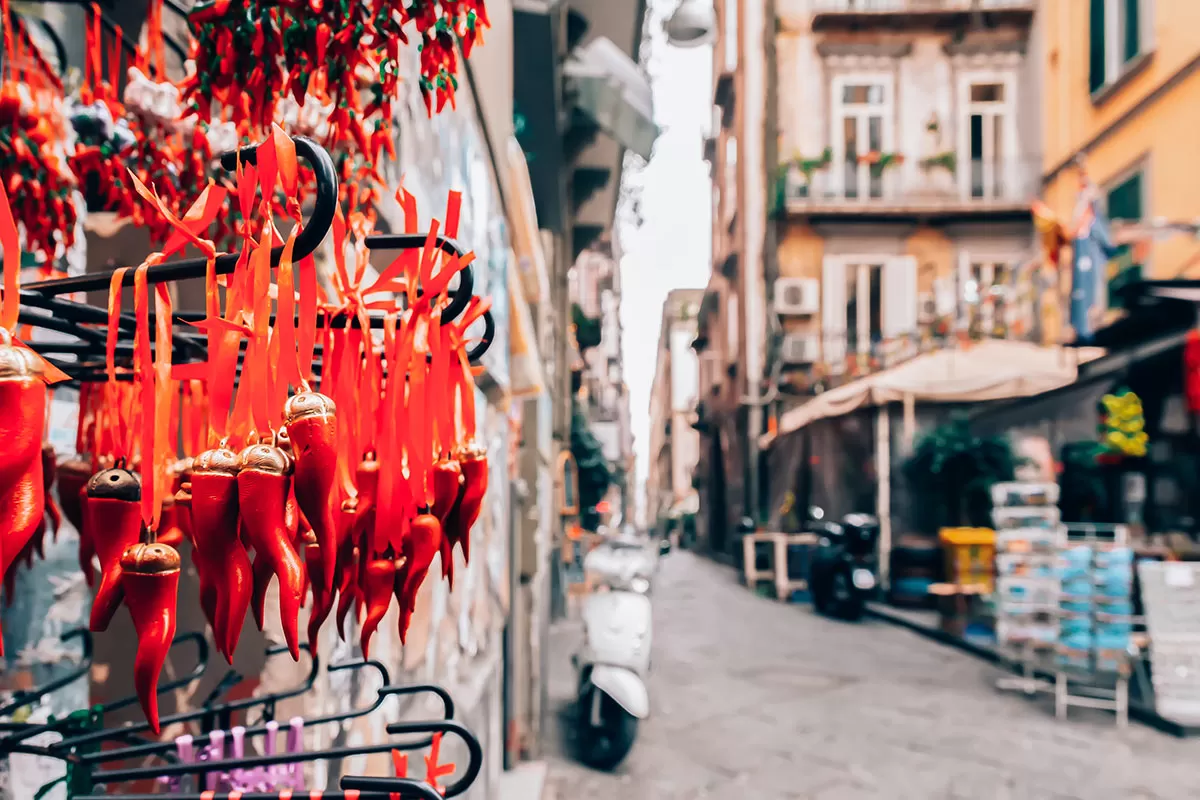
A cornicello is a traditional Neapolitan good luck charm
The Italian Language aka la bella lingua
The Italian language is a ‘distant relative’ of English and is often considered one of the easiest languages for English-speakers to learn. Want to know more about Italian? Read on!
- Italian is the official language of Italy, San Marino, Switzerland and Vatican City. It’s also the official language of some parts of Croatia and Slovenia.
- As of 2020, there are 67 million people in Europe who speak Italian as their first language. A further 13.4 million people speak Italian as a second language. Italian is also spoken by large expatriate communities in the Americas and Australia. Fun fact: My dad immigrated to Australia back in 1950s, which makes me a heritage Italian language learner.
- Apart from Italian, 12 minority languages are recognized in Italy, including Albanian, Catalan, French, German, Greek, Slovene, and Sardinian.
- Located in the Dolomite Mountains in Northern Italy in the provinces of South Tyrol, Trentino, and Belluno, is the Ladin people who speak Ladin – a Romance language that shares similarities to Swiss Romansh and Friulian.
- The Italian language is a Romance language with its roots in Vulgar Latin. It is closely related to French and Spanish, with around 80% lexical similarities. These languages are not mutually intelligible, but if you already know one of them, you can learn the others quite easily.
- Of all the Romance languages, Italian is the closest to Latin.
- Italian is the language of music. Allegro, adagio, piano, forte – all these are Italian words. Music notation as it is used today was created by an Italian named Guido d’Arezzo.
- There are only 21 letters in the Italian alphabet. Letters J, K, W, X, and Y aren’t used in Italian.
- Italian has a formal and informal way to say ‘you’. Unlike in English, our version of being formal and informal is the difference between not swearing or just using more sophisticated words. In Italian (and many other languages) there are two different ways to say ‘you’. The formal way and the informal way. You use the informal pronoun tu (too) (you) when speaking with good friends, young people, children, and your family members. Basically, anyone you know well. However, when speaking to a person you don’t know well such as a superior, shopkeeper, waiter, teacher, professor, or someone of important social standing such as a doctor, or police officer, then you should address him or her formally — that is, with Lei (lay) (you).
- Thinking of learning Italian? The good news is that Italian is among the easiest languages for English-speakers to learn.
- Dante Alighieri is considered the ‘Father of the Italian language’ as he and his works contributed a lot to standardizing Italian.
- Italians speak with their hands and gestures nearly as much as they do with words, and some people find it nearly impossible to express themselves without gestures.
- Many believe Italian to be one of the most beautiful languages in the world. Why? Dr Patti Adank of the University College London says that Italian is attractive to the ear because of its so-called ‘melody’. Italian consists of a large number of words that end in vowels, and a few words with consecutive consonants in a row, this creates an open sound that makes it perfect for singing. In fact, the Holy Roman Emperor Charles V allegedly said, ‘I speak Spanish to God, Italian to women, French to men and German to my horse.’
- There are many regional dialects of the Italian language that can differ a lot from each other, especially in pronunciation. For example, in Naples the Napoletano dialect is spoken and in Rome, Romans speak Romanesco. The diversity and number of dialects found in Italy is largely due to the fact that many medieval cities were well protected and therefore remained conquered or invaded by outsiders.
- The word quarantine dates back to the days of the Bubonic Plague in Venice where this word originates. ‘Quaranta’ means ‘forty’ in Italian. Ships entering Venice were forced to anchor offshore for a full 40 days to prevent the spread of the disease.
- Italian has a lot of food-related expressions. A common proverb is A tavola non si invecchia mai, meaning ‘one doesn’t grow old at the dinner table’ therefore you should take your time and enjoy the moment. There are also plenty of Italian food-related insults natives will often use, including Sei come il prezzemolo! (You’re like parsley), in other words, ‘you turn up everywhere’ and Non fare il salame! (Don’t act like salami!) or ‘Don’t be an idiot!
- The term ‘milestone’ comes from the ancient Romans. After the Imperial Forum in Rome was built, the Romans placed a stone there and then they placed additional markers on the roads leading out of Rome. Each of these markers was placed at a distance of 1,000 paces. Since a pace was approximately 5 ft, 1,000 paces was approximately 5,000 ft in modern measurements. Since the unit of length was 1,000 paces, the Romans called the distance a ‘mila’, the Latin word for ‘thousand’. We’ve taken this measurement in English as ‘mile’ and that’s why a modern mile comes from the Latin word for ‘thousand’ but it actually represents a measurement of slightly more than 5,000 ft in modern measurements. Each of these markers was called a ‘milliarium’ and this word comes into English as ‘milestone’. So, as you travelled in and out of Rome, you passed a’ milestone’ every 1,000 paces. This was a mark indicating how far you had come or how far you had left to go, and it’s in this sense that we’ve inherited the term ‘milestone’, to refer to a level of achievement or accomplishment.
- Italian words have a grammatical gender which means that they can be either feminine or masculine. It’s important to note that you shouldn’t confuse these grammatical terms with the biological terms ‘male’ and female’. After all, a pizza is not technically a girl, even though it has a feminine grammatical gender, and risotto isn’t a boy even though it is masculine, grammatically speaking. Sound strange? The English language used to have grammatical gender too. You can still see remnants of grammatical gender in words like blonde and blond.
- Vatican City has ATM’s in Latin. Yes, The Vatican is the only country in the world to have ATM’s that speak Latin to you as you withdraw money. Latin is the official language of the Vatican which is why you can choose this language option. Rumor has it, that the former Pope Benedict XVI, made his transactions in Latin.
Landmarks in Italy
Italy is a country of both natural and architectural beauty. In this section, we have collected a few fun facts about some of the Italian landmarks.
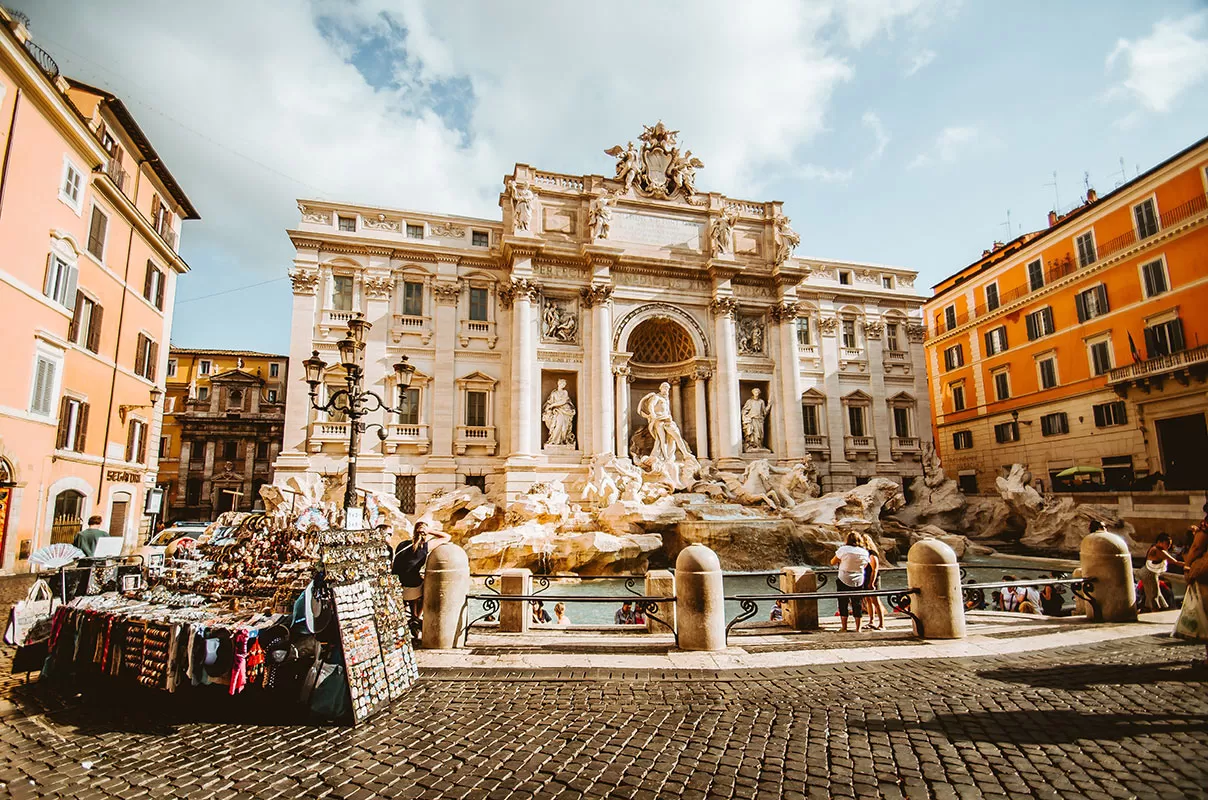
- Rome, the capital of Italy, is home to hundreds of fountains. There are 50 fountains in the city that can be considered large, including the oldest and most famous Trevi fountain. There are also multiple smaller fountains with the exact number impossible to count.
- The Trevi Fountain, (Fontana di Trevi in Italian) is Italy’s largest and most famous Baroque fountain, standing 85 feet high and 65 feet across. The fountain is located at the junction of three roads (tre vie) which marks the terminal point of the ‘modern’ Acqua Vergine aqueduct, the revived Aqua Virgo, one of the aqueducts that supplied water to ancient Rome. In 19 BC, supposedly with the help of a virgin, Roman technicians located a source of pure water some 13 km (8.1 mi) from the city. (This scene is presented on the present fountain’s façade.) However, the eventual indirect route of the aqueduct made its length some 22 km (14 mi). This Aqua Virgo led the water into the Baths of Agrippa. It served Rome for more than 400 years.
- Tourists throw almost €3,000 into the Trevi fountain every day, which adds up to about €1,000,000 a year! Legend has it that tossing a coin into the fountain means that you will no doubt return to Rome, and it seems like a lot of people want to return.
- Italy has the most UNESCO World Heritage sites – 55, as of 2019. There is only one country in the world that can boast the same number – China.
- The lagoon city of Venice doesn’t have any cars (except for the area around the train station). Located in Northern Italy, Venice is built on 120 islands and its canals are its streets. Since there are no cars (or roads), the only way to get around is by water transportation.
- Florence is the birthplace of the Renaissance.
- The Colosseum in Rome is one of the most recognized Italian landmarks. This huge arena could sit over 50,000 spectators.
- One of the most spectacular buildings in Italy is the Milan cathedral, which took almost six hundred years to complete. It is called Duomo di Milano in Italian and is one of the largest church buildings in the world.
- The biggest and probably the most famous cathedral in the world is St Peter’s Basilica in Vatican City. There are 284 columns flanking the cathedral square, and the dome alone is 42 meters high.
- St. Peter’s Basilica isn’t a cathedral—or the official seat of the Pope. For all its importance, St. Peter’s Basilica isn’t the official seat of the Pope. Nor is it first in rank among Rome’s basilicas. Both of those accolades go, instead, to San Giovanni in Laterano (St. John Lateran), the mother church of the Roman Catholic church. But because of the size of St. Peter’s, and its location next to the residence of the Pope, most of the Church’s most crucial ceremonies are held here instead.
- The Colosseum in Rome is the largest amphitheatre (meaning ‘theatre in the round’) in the world! Measuring 189 m long, 156 m wide and 50 m high, this ancient sporting arena is also known as the Flavian Amphitheatre because it was built during the Flavian dynasty. It got the name Colosseum because of a statue that was located alongside the amphitheatre called ‘the colossus of Nero’. Unknown to many visitors is that Nero’s hidden palace Domus Aurea is located opposite the Colosseum.
- The name of the famous leaning tower in the city of Pisa comes from a Greek word meaning ‘marshy land’. The tower is leaning because its shallow and heavy foundation was not a good match for the soft soil. The tower, in fact, still continues to lean because of this however it has since been stabilized so it’s unlikely to fall in the foreseeable future.
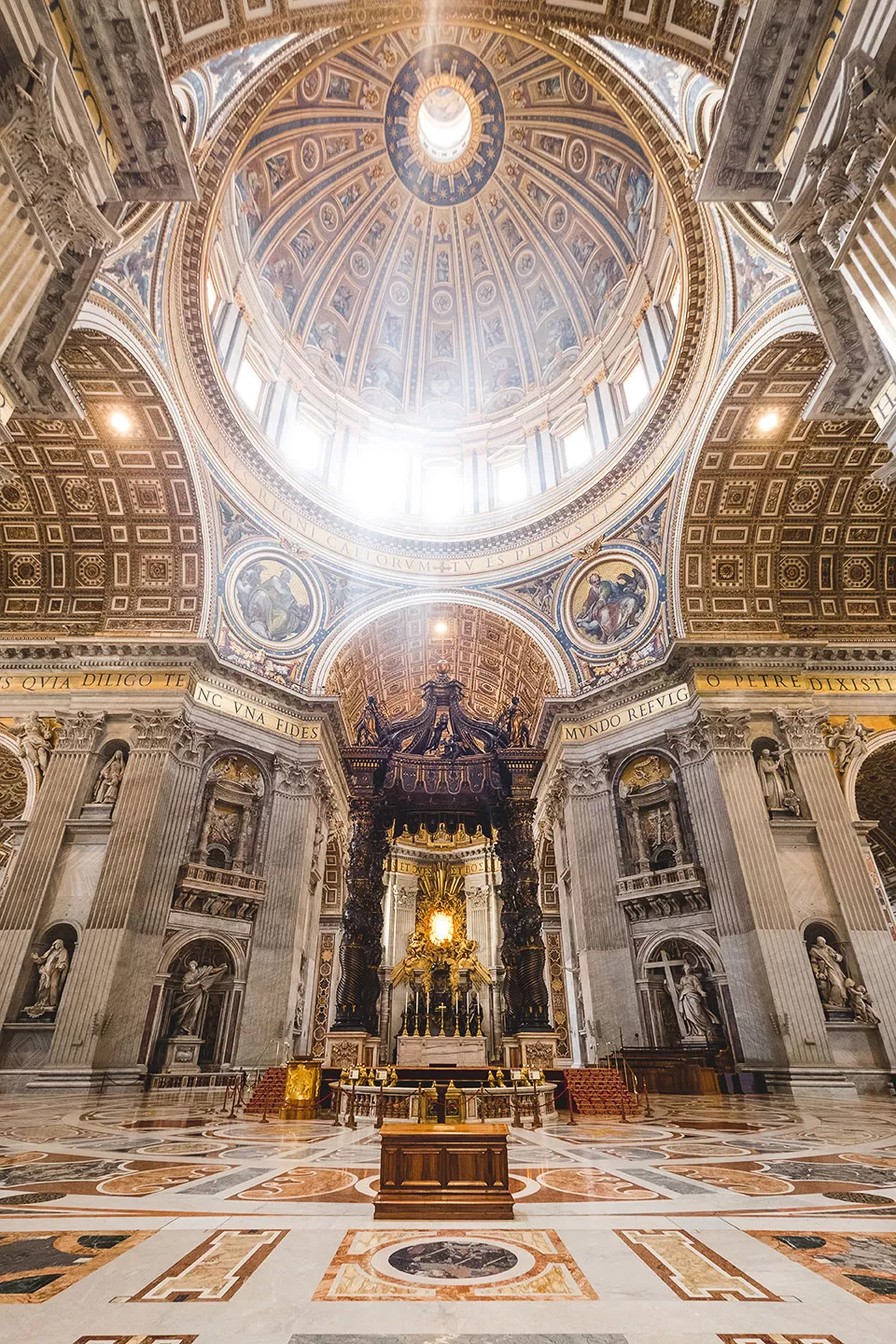
Natural wonders in Italy
Italy is a relatively small country (a little over 300 000 square kilometers) but it is large enough to be home to some amazing natural wonders.
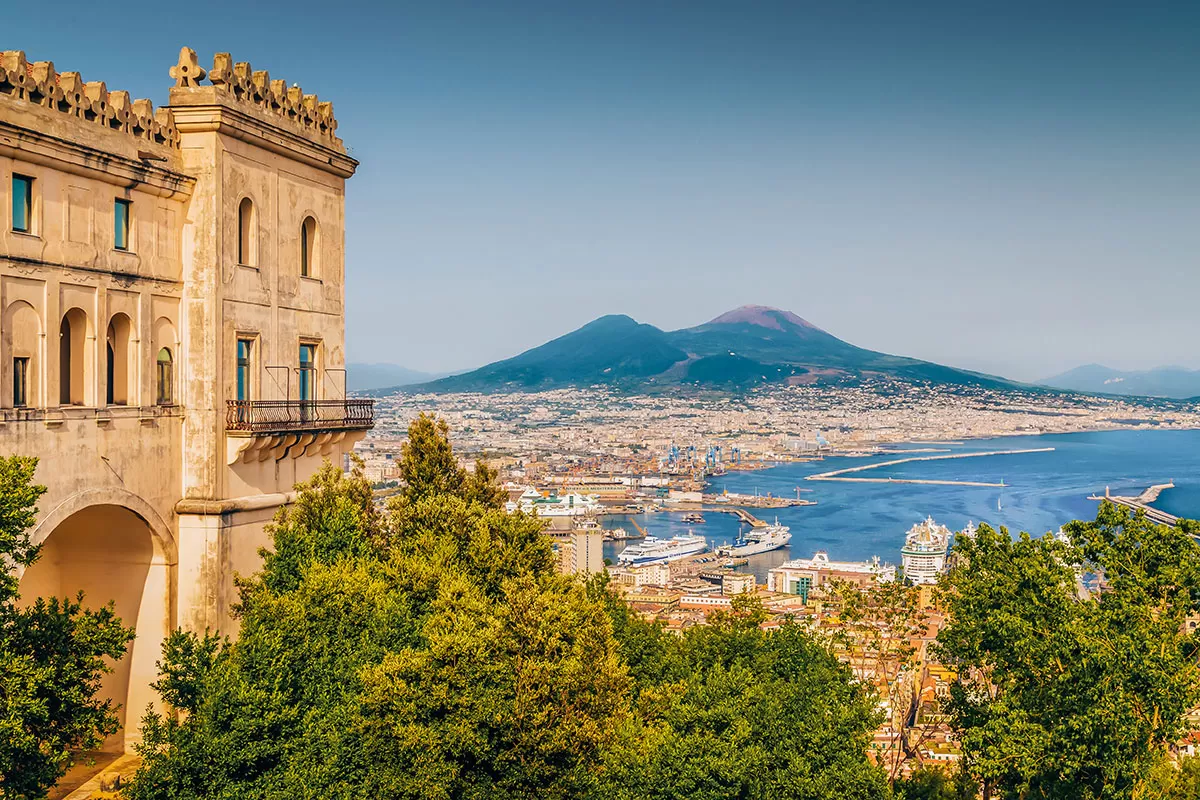
- Italy has more volcanoes than any other country in Europe. It lies on a fault line, which causes volcanoes to form. Many of Italy’s Italian volcanoes are still active, including the famous Mount Vesuvius (the only active volcano on mainland Italy), Mount Etna (located in Sicily) and Mount Stromboli (located on the Stromboli island in the Tyrrhenian Sea) which has been in almost continuous eruption for the past 2,000–5,000 years. Volcanoes are beneficial in that they provide fertile soil for crops.
- About 80% of the Italian landscape is made up of hills and mountains, which is another consequence of the country being located on a fault line. It is one of the things that gives the country its particular charm, and it has inspired many works of art.
- Italy is separated from the other countries by the Alps. This mountain range is located in the north of Italy and runs along the full length of the border.
- The highest mountain in Europe is located in the Alps on the French-Italian border. Called Mont Blanc in French and Monte Bianco in Italian, its highest peak is (15,771 feet [4,807 metres]).
- There are over 1,500 lakes in Italy, which is quite a lot for a relatively small country. Some are surrounded by mountains, others by sandy beaches, big and small – you can spend your whole vacation enjoying Italian lakes.
- The two main mountain ranges in Italy are the Alps (which run across the top of Northern Italy) and the Apennines which run vertically down the centre of Italy.
- Italy has two big islands, Sicily and Sardinia, as well as lots of smaller ones – over four hundred. It is estimated that 1 in every 10 Italian lives on an Island.
- There is a sea cave called Grotta Azzurra on the island of Capri. ‘Azzurra’ means ‘blue’ in Italian. Due to the unusual refraction of sunlight, the water in this cave appears incredibly blue. You can visit it by taking a boat ride but be careful not to bang your head on the very low entrance to the cave.
- Earthquakes are frequent in Italy with the last major earthquake, measuring 6.2 ± 0.016 on the moment magnitude scale. It hit Central Italy on 24 August 2016 where 299 people died.
- Italy is surrounded by four seas: the Adriatic Sea, Tyrrhenian Sea, Ionian Sea, and the Mediterranean Sea, and borders four countries: France, Switzerland, Austria, and Slovenia all in the north.
Italian Food and Cuisine
Practically the whole world eats pizza and pasta. But how well do you really know Italian cuisine? Let’s find out!

- Italy introduced many popular foods to Europe. This includes not only the obvious pizza and pasta but also such things as coffee and ice-cream (gelato): these foods didn’t originate in Italy but have been popularized by them.
- The first McDonalds opened in Rome in 1986 and caused protests. Italians are very proud of their cultural heritage and their cuisine in particular, and it is no surprise that they opposed this fast-food chain.
- Pasta used to be a sweet dish. Pasta was first brought to Italy in the 13th century. At that time, it was served with honey and sugar – and eaten with your fingers!
- There are approximately 350 different kinds of pasta. In Italy, names may vary according to the region or area.
- There is a free wine fountain in Caldari di Ortona in Italy. It flows 24/7 with a locally grown red wine.
- Italians drink around 14 billion espressos a year – which is quite impressive for only 60 million people. An average household in Italy goes through 37 kilograms of coffee per year.
- On average, Italians consume 25 kilograms of pasta per year.
- One of the things Italy is famous for is its cheeses: there are over 2,500 traditional cheeses in the country including Gorgonzola, Pecorino Toscano, Taleggio, Fontina d’Aosta, Parmigiano-Reggiano, Mozzarella di Bufala, Provolone, Mascarpone and Ricotta.
- Italy is the world’s largest wine producer and exporter.
- Tiramisú is not just a name of a popular Italian dessert, it is a whole phrase calling on you to pick up the dessert and eat it: ‘tiramisu’ can be translated into English as ‘pick me up’. In turn, the desserts high energy content and caffeine will ‘pick you up’
- Pizza was invented in Naples. As the story goes, on June 11, 1889 the now world-famous original Margherita pizza was created by the Neapolitan pizzamaker Raffaele Esposito in honour of the Queen consort of Italy, Margherita of Savoy. Raffaele created the Pizza Margherita, to represent the national colours of Italy as on the Flag of Italy. Basil (green), mozzarella (white) and tomatoes (red).
- The concept of take-out food dates back to ancient Rome.
- Italians eat a lot of bread – about half a pound a day.
- The famous Venetian dish, Bacalà alla Vicentina, was inspired after an Italian sea captain was shipwrecked in Lofoten, Norway. Norway exports 40 million kilos of dried codfish each year, most of which are sent to Italy. It all started with Pietro Querini, an Italian sea captain from Venice who in 1432 was shipwrecked in Røst, a small island in the Lofoten archipelago. While recuperating on the island, Querini discovered codfish which he called ‘stocfisi’ (Tørrfisk in Norwegian), which dominated the local economy and was air- and wind-dried until it became ‘as hard as wood’. When Querini left for Venice four months later, he took 60 sticks of air-dried cod with him. The Venetians were not particularly impressed, though: there was plenty of local lagoon fish to eat and leathery Norwegian cod didn’t have quite the same appeal.
When Querini eventually returned to Venice, he took 60 sticks of air-dried cod with him and wrote a report of his travels. Querini is famed for having popularised Stockfish, particularly codfish, in the Veneto region where it is prepared as Bacalà alla Vicentina.

Italian Fashion
Names like Gucci, Versace, Prada, and Dolce & Gabbana are known all over the world, even to people who have nothing to do with fashion. Here are a few facts about Italian fashion and Italian fashion brands.
- Italian fashion is concerned much more about elegance than comfort.
- Italians often choose to have fewer high-quality, well-made clothes rather than having lots of cheap ones.
- Dolce & Gabbana is a popular Italian brand, but they opened their first store in Japan, in 1989.
- Each region in Italy has its own unique traditional costume. However, similar to many other countries, these costumes are only worn during special festivals and celebrations.
- Rome and Milan are often listed among the world’s top fashion capitals.
- Italy ranks as one of the top countries in terms of leather crafts and production. Many Italian regions have a long-standing tradition of leather treatment, and the quality of Italian leather is truly superior.
- In Italy, there are two main police forces. The regular state police, the Polizia, and the Carabinieri. During the 1980s, Italian fashion designer Giorgio Armani designed the new more modern uniforms.
More surprising Italy facts you probably didn’t know
There are many more fun facts about Italy out there, and not all of them fit easily into a category – but they are still worth learning, and we have gathered some of them in this final section.
- Thirteen of Shakespeare’s 38 plays are set in Italy, including his most famous Romeo and Juliet which is set in Verona. Shakespeare is an English writer with a special love for Italy as a setting for his plays. There is no evidence that he himself spent any time in Italy, but the depictions of the country in the place are quite accurate.
- The Italian polizia (police) drive Lamborghinis. There are only a few police Lamborghinis in the whole country, but where else on Earth would you find one if not in Italy?
- The first-ever pair of eyeglasses were made in Italy in the late 13th century.
- Alessandro Volta is the Italian scientist who created the first battery in 1800. The unit of power, the volt, is named after him.
- Galileo Galilei (1564-1642) invented the thermoscope, an instrument that indicated temperature differences, which led to the invention of the thermometer by Santorio Santorio (1561-1636) – a Venetian scientist.
- The jacuzzi was invented by Italian engineer Candido Jacuzzi, who created the original portable, in-home Jacuzzi Whirlpool Bath.
- Da Vinci invented many things which we still use today, including the Barreled cannon (the automatic weapon), helical aerial screw (the helicopter), the anemometer (to measure wind speed and direction), the revolving bridge, a winged flying machine (the airplane), diving equipment, self-propelled cart (the car) and the parachute.
- The Mafia still exists in Italy and is estimated to make up 7% of the country’s entire GDP.
- It is against the law to die in the town of Falciano del Massico located 30 miles from Naples. The town’s cemetery is full and they passed this law to try and control death. There is a bronze statue of Jesus Christ submerged in the Mediterranean Sea near the coast of San Fruttuoso.
- Poveglia Island in Italy is believed to be haunted – to such an extent, in fact, that access by the public is banned.
- Around 500,000 exorcisms are performed in Italy each year.
- La Festa della Repubblica is the Italian National Day and Republic Day, which is celebrated on 2 June each year, with the main celebration taking place in Rome. On 2 and 3 June 1946, an institutional referendum was held where Italians voted for their preferred form of state – monarchy or republic. The referendum was announced at the end of World War II, a few years after the fall of the Fascist regime in Italy.
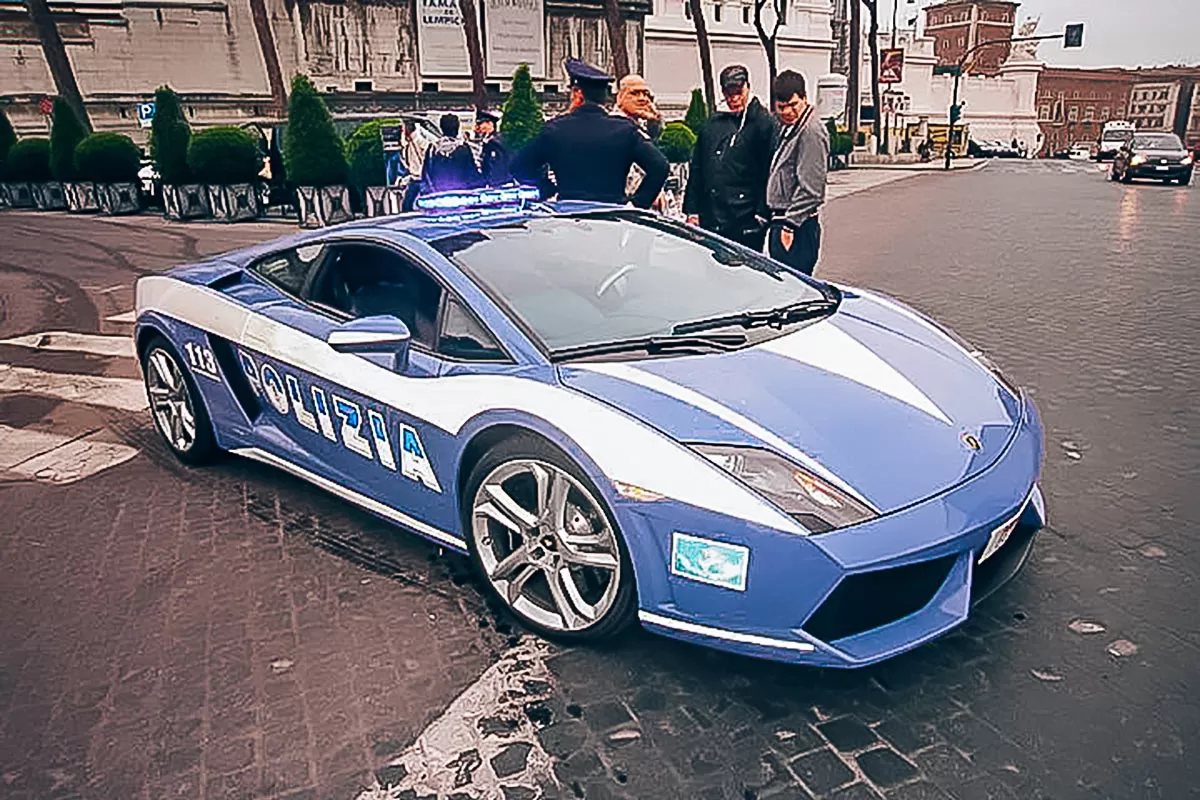
Don’t be treated like a tourist. Learn Italian with my 80/20 method
Travelling to Italy? Don’t be treated like a tourist! Live your best travel experiences and learn Italian for less than the cost of eating at a tourist trap restaurant or a taxi driver who has “taken you for a ride”. I’ve made it easy for you to master the Italian language so you can create lifelong memories as you mingle with locals, get local tips, avoid tourist traps, and make new friends. Who knows, you may even be invited over for afternoon tea by a lovely Sicilian family like I was! Read all about how speaking Italian changed my life and check out my online Italian video course here.
Here’s what my students are saying:

I really enjoyed the Intrepid Italian course, it certainly exceeded my expectations. The learning methodology is great, and easy to follow and found that I progressed much faster in the last 4 weeks than I ever did on my own or using other language apps. Grazie mille Michele, I can’t wait until I can put my new skills into action! – Roma Small
Click here for instant access!
Don’t miss these Italy travel guides
- 33 Italy Travel Tips That Will Save You Time, Money and Disappointment
- Best Time to Visit Italy // PLUS Tips to Avoid Crowds and SAVE $$$
- Where to Stay in Rome | Best Hotels and Best Neighborhoods to Stay in Rome
- 29 Amazing Day Trips from Rome By Train, Car & Guided Tour
- 21 Unique Things to Do in Venice You Should Try at Least Once
- Rome Tips and Tricks: 27 Things You Should Know Before You Go to Rome
- Top 10 Things to Do in Rome That Aren’t On Your List
- Top 10 Absolute Best Views of Rome That Will Blow Your Mind
- Domus Aurea: Visit Rome’s Secret Hidden Palace
- 36 Wonderful Things to do in Umbria, Italy (PLUS Map of Umbria)
- Self-Guided Trastevere Walking Tour: Where to See Rome’s Most Beautiful Streets
- Absolute Best Things to do in Verona, Italy | 26 Must-See Attractions
- Top 7 Authentic Tours and Experiences in Rome [Run by Locals]
- Lakes, Mountains & Castles: 21 Best Things to do in Trento, Italy
- Where to Stay in Verona: Best Hotels in Verona Neighbourhoods
- Where to Stay in Venice | Best Hotels in Venice for Every Budget
- 27 Best Things to Do in Trieste, Italy (PLUS Map, BEST Tours & Day Trips)
Like it? Pin it for later!
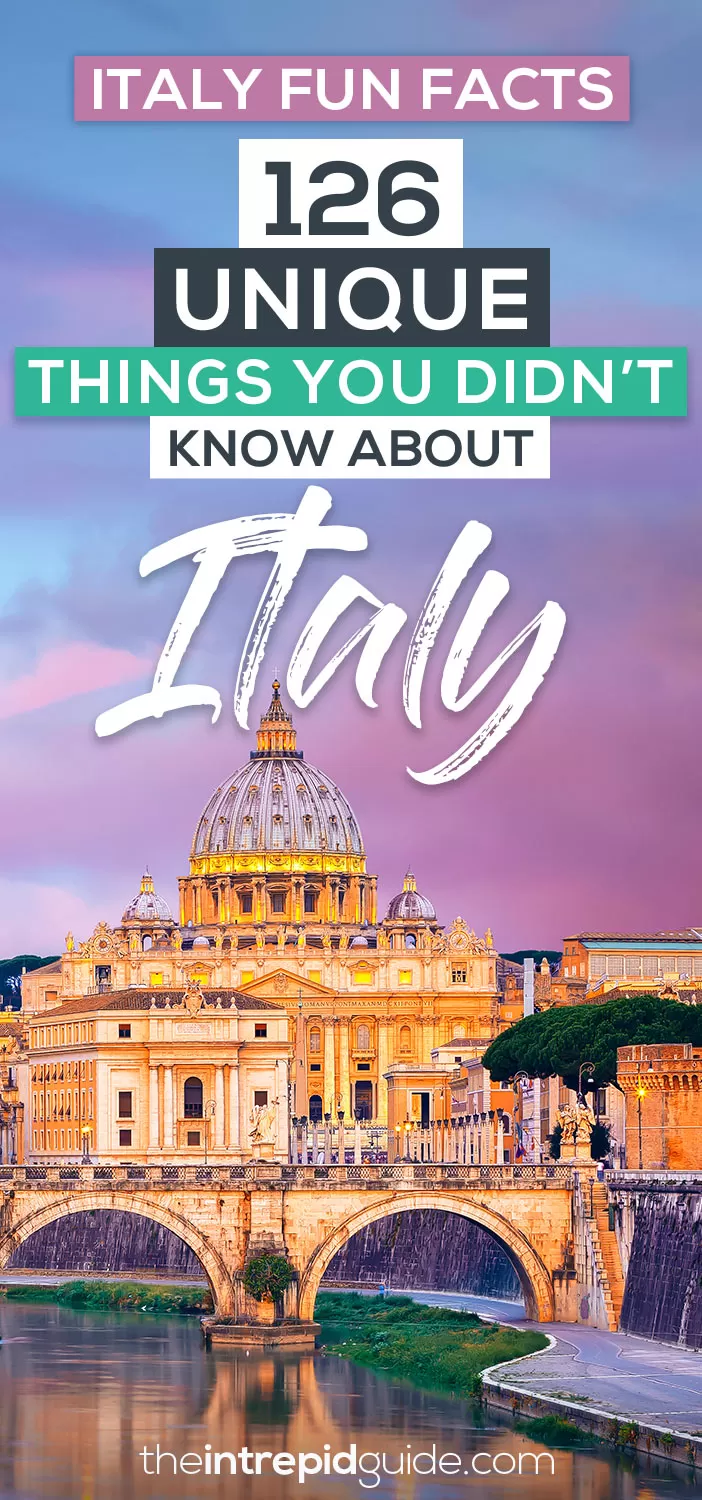
Over to you!
Which of these facts about Italy surprised you the most? What else would you add to this list?
Let me know using the comments section below or join me on social media to start a conversation.
Thanks for reading and I hope you enjoyed this post.
Like what you see? Subscribe using the form below to have all of my posts delivered directly to your email.

